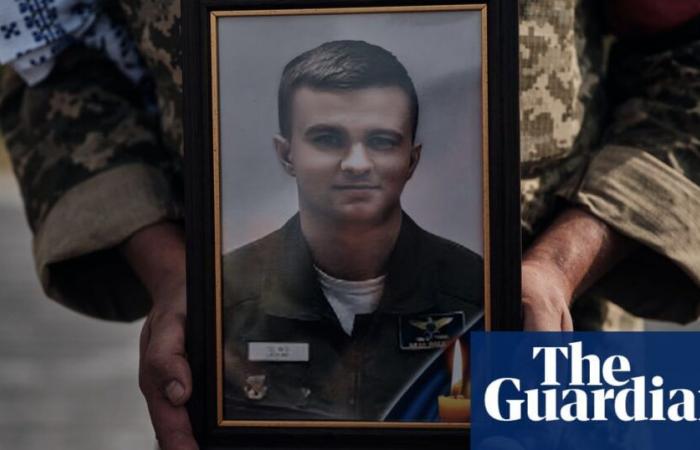Volodymyr Zelenskiy has fired the head of Ukraine’s air force a day after it emerged that a recently delivered F-16 jet had crashed earlier this week, killing the pilot.
“I have decided to replace the commander of the air forces … I am eternally grateful to all our military pilots,” Zelenskiy said in his evening video address on Friday, without giving a reason for the dismissal of Mykola Oleshchuk.
But Zelenskiy spoke of the need to “protect” the lives of those defending the country, suggesting the dismissal is probably related to the F-16 crash in which Lt Col Oleksiy Mes died.
The arrival of the F-16s, donated by a number of European nations, was delayed due to the lengthy training programme required for pilots and ground staff to be able to operate the aircraft.
Mariana Bezugla, a member of a parliamentary defence committee, had earlier claimed the plane was shot down by friendly fire. Reuters cited a US official stating the plane did not appear to have been hit by Russian fire, and the crash may have been caused by mechanical failure or pilot error.
The crash was more unwelcome news in a week when Russia has continued to make rapid advances in eastern Ukraine toward the key city of Pokrovsk, sparking public criticism of the Ukrainian military leadership and Zelenskiy even as the bold incursion into the Russian Kursk region continues.
For months, Russian forces have been attempting to seize Pokrovsk, a strategically important mining town with a prewar population of about 60,000, but their advance has gained considerable momentum in recent weeks.
Deep State, a Ukrainian group close to Ukraine’s defence ministry that tracks frontline activities, reported that Russian forces on Friday were less than 10km (6 miles) from the outskirts of Pokrovsk, where local officials have ordered a mass evacuation.
Russian pro-war military bloggers also reported on Friday that forces had entered the city of Selydove, south of Pokrovsk.
As Vladimir Putin’s troops advanced, Russia also shelled a residential building and a children’s playground in Kharkiv, killing at least five people, including a child, and leaving 40 people injured, according to the city’s mayor.
Videos circulating on social media showed flames pouring out of the high-rise building, which officials said was hit by a glide bomb. Kharkiv, Ukraine’s second largest city, has been shelled relentlessly since the start of Russia’s invasion.
Located at the intersection of several key roads, Pokrovsk facilitates the supply of Ukrainian forces across a broad frontline and its loss could open the way for further Russian advances in the Donetsk region.
“The situation is very bad, and it deteriorated quickly,” said a commander whose troops are stationed near Pokrovsk, speaking on the condition of anonymity, as he was not authorised to speak publicly on the matter. “Time will tell if we should have sent troops to Kursk instead of defending the east. But for now, we are suffering.”
Kyiv’s surprise incursion into Russia’s Kursk region earlier this month provided a welcome boost to morale at home and raised hopes that the gutsy attack might prompt Moscow to redeploy its troops away from the eastern front.
But more than three weeks into the operation, Ukraine’s military has admitted that Russia has not yet committed its forces in eastern Ukraine to recapture its own territory, while Kyiv’s progress in the Kursk region has significantly slowed down.
Ukraine’s top general, Oleksandr Syrskyi, said last week that Moscow had redeployed 30,000 troops to recapture its territories in the Kursk region, with some troops shifted from the occupied south of Ukraine.
Crucially, he also said that Russia was simultaneously increasing its efforts in the Pokrovsk sectors.
Ukraine continues to hold a chunk of Russian territory and in Sumy, the Ukrainian city closest to the operation, signs of the incursion are everywhere, with an increased military presence in the city and frequent sightings of military hardware heading towards Russia.
after newsletter promotion
On Friday, Russian strikes on Sumy killed two women and wounded eight other people, regional officials said, claiming that guided air bombs had been used to strike a factory. There are regular strikes on areas close to the border. Regional authorities urged residents of these areas to evacuate as soon as possible. Already, more than 20,000 people have left the border areas.
A popular Ukrainian commentator and officer in the army’s reserves, who goes by the online handle Tatarigami, said the breach in the frontline in the Donetsk region was “worsened” by the Kursk offensive, which he said “diverted experienced and motivated brigades, stripping stabilisation reserves and allowing Russian forces to advance rapidly.”
He also accused the Ukrainian military leadership of underplaying the gravity of the situation. “Unfortunately, the high command is still receiving reports about the ‘controlled situation’, which is far from being controlled … Lies, lies, lies,” he tweeted.
Zelenskiy this week rejected charges that the redeployment of experienced troops to Kursk had weakened Ukraine’s position in Pokrovsk. During a press conference on Tuesday, he described the situation in Pokrovsk as “extremely difficult” but argued that the incursion had actually slowed Russian advances toward the city.
However, open-source data, along with military analysts close to the Ukrainian military and pro-Russian bloggers, paints a different picture, showing a deteriorating frontline since 6 August, when Ukrainian forces first entered Kursk.
Even before Ukraine decided to send troops to Kursk, the country had been on the back foot in the east for months, grappling with delayed western aid while its forces remained outnumbered and exhausted.
Some Ukrainian soldiers have stated that the Kursk incursion was not to blame for the collapse on the frontlines. Instead, they attribute the difficulties to troop exhaustion. Some soldiers have been engaged in combat since the start of the invasion more than two years ago.
“At the moment, it looks like our front in Donbas has collapsed,” Roman Ponomarenko, a brigade officer at the revered Azov Brigade, wrote on Telegram.
“The defence of the Ukrainian armed forces is disorganised, the troops are tired, weakened, and many units are demoralised … and it’s not because of the Ukrainian armed forces’ operation in Kursk.”
Ukraine has since managed to partially replenish its forces through strict new government conscription laws that have lowered the draft age from 27 to 25. However, the newly mobilised troops are apparently being sent to the frontlines with limited training.
“The replenishment received is mostly untrained and does not help; instead, it complicates the combat operations of the units,” Ponomarenko wrote.
In an interview last week with Associated Press, a battalion commander in Ukraine’s 47th Brigade said some of the newly mobilised soldiers “don’t want to shoot”: “They see the enemy in the firing position in trenches but don’t open fire … that is why our men are dying.”






